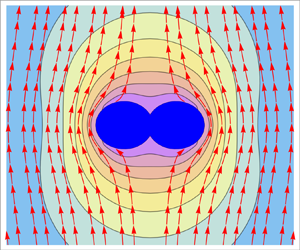Article contents
Efficient simulation of non-classical liquid–vapour phase-transition flows: a method of fundamental solutions
Published online by Cambridge University Press: 01 June 2021
Abstract

Classical continuum-based liquid–vapour phase-change models typically assume continuity of temperature at phase interfaces along with a relation which describes the rate of evaporation at the interface (Hertz–Knudsen–Schrage, for example). However, for phase-transition processes at small scales, such as the evaporation of nanodroplets, the assumption that the temperature is continuous across the liquid–vapour interface leads to significant inaccuracies (McGaughey et al., J. Appl. Phys., vol. 91, issue 10, pp. 6406–6415; Rana et al., Phys. Rev. Lett., vol. 123, 154501), as might the adoption of classical constitutive relations that lead to the Navier–Stokes–Fourier (NSF) equations. In this paper, to capture the notable effects of rarefaction at small scales, we adopt an extended continuum-based approach utilising the coupled constitutive relations (CCRs). In CCR theory, additional terms are invoked in the constitutive relations of the NSF equations originating from the arguments of irreversible thermodynamics as well as being consistent with the kinetic theory of gases. The modelling approach allows us to derive new fundamental solutions for the linearised CCR model, to develop a numerical framework based upon the method of fundamental solutions (MFS) and enables three-dimensional multiphase micro-flow simulations to be performed at remarkably low computational cost. The new framework is benchmarked against classical results and then explored as an efficient tool for solving three-dimensional phase-change events involving droplets.
- Type
- JFM Papers
- Information
- Copyright
- © The Author(s), 2021. Published by Cambridge University Press
References
REFERENCES
- 13
- Cited by



